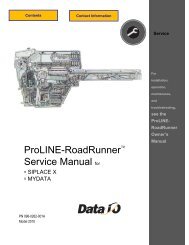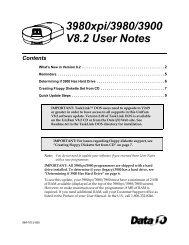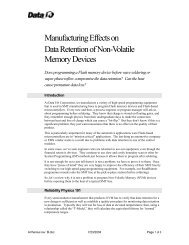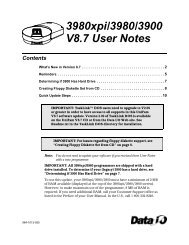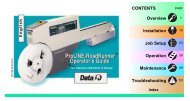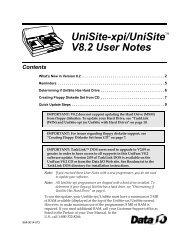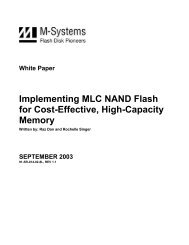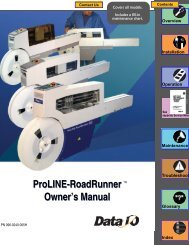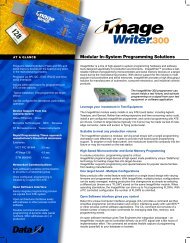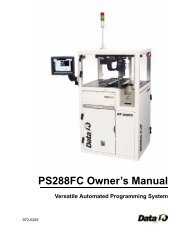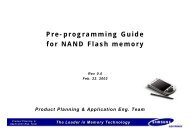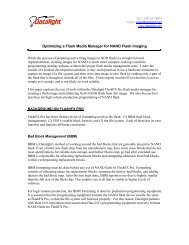TaskLink (DOS) and AutoSite (with Hard Drive) - Data I/O Corporation
TaskLink (DOS) and AutoSite (with Hard Drive) - Data I/O Corporation
TaskLink (DOS) and AutoSite (with Hard Drive) - Data I/O Corporation
Create successful ePaper yourself
Turn your PDF publications into a flip-book with our unique Google optimized e-Paper software.
Contents<strong>AutoSite</strong>V8.2 User NotesWhat’s New in Version 8.2 . . . . . . . . . . . . . . . . . . . . . . . . . . . . . . . . . . . . . . . . 2Reminders . . . . . . . . . . . . . . . . . . . . . . . . . . . . . . . . . . . . . . . . . . . . . . . . . . . . 5Determining if Programmer Has <strong>Hard</strong> <strong>Drive</strong> . . . . . . . . . . . . . . . . . . . . . . . . . . . 7Creating Floppy Diskette Set from CD . . . . . . . . . . . . . . . . . . . . . . . . . . . . . . . 8Quick Update Steps . . . . . . . . . . . . . . . . . . . . . . . . . . . . . . . . . . . . . . . . . . . . 10IMPORTANT: <strong>TaskLink</strong> <strong>DOS</strong> users need to upgrade to V2.09 orgreater in order to have access to all supports in this UniFam V8.2software update. Version 2.09 of <strong>TaskLink</strong> <strong>DOS</strong> is available on theUniFam V8.2 CD or from the <strong>Data</strong> I/O Web site. See Readme.txt inthe <strong>TaskLink</strong> <strong>DOS</strong> directory for installation instructions.IMPORTANT: For issues regarding floppy diskette support, see“Creating Floppy Diskette Set from CD” on page 8.Note: You do not need to update your software if you received these User Notes<strong>with</strong> a new programmer.IMPORTANT: Before completing the appropriate Quick Update, see“Determining if Programmer Has <strong>Hard</strong> <strong>Drive</strong>” on page 7.To use this update, your <strong>AutoSite</strong> must have a minimum of 2 MB of RAMavailable (displayed at the top of the <strong>AutoSite</strong> screen). However, to makemaximum use of the programmer, 8 MB of RAM is required. If you needadditional RAM, call your Customer Support office as listed in the Prefaceof your User Manual. In the U.S., call 1-800-332-8246.984-1022-047
What’s New in Version 8.2• Device Lists on “UniFam 8.2/<strong>TaskLink</strong> 6.0” CDLists of new <strong>and</strong> updated devices can be found on the “UniFam 8.2/<strong>TaskLink</strong> 6.0”CD in \Update_Info.• Update from “UniFam 8.2/<strong>TaskLink</strong> 6.0” CDThe “UniFam 8.2/<strong>TaskLink</strong> 6.0” CD contains all the software required for updatingyour programmer. <strong>TaskLink</strong> for Windows® allows for easy installation of“UniFam 8.2” CD contents (Boot File, System Files, <strong>and</strong> Algorithm Sets).For instructions on how to install “UniFam 8.2” programmer software from CD,see <strong>TaskLink</strong> for Windows Help <strong>and</strong> select “How to Update System Software.”Please note that after inserting the “UniFam 8.2/<strong>TaskLink</strong> 6.0” CD into your CDdrive, the <strong>TaskLink</strong> install program will begin. If you do not wish to install the latestversion of <strong>TaskLink</strong>, simply close the <strong>TaskLink</strong> install program. You must use<strong>TaskLink</strong> 4.50 or greater to install your UniFam V8.2 programmer software update.Note:Software updates from CD work only on programmers <strong>with</strong> a hard drive.Contact <strong>Data</strong> I/O Sales for information on upgrading your programmer to ahard drive.• Philips Semiconductor ChangesEffective in V7.3, Philips Semiconductor requested that we update the followingdevice menu selections to conform <strong>with</strong> their latest programming specificationchanges:Old NameNow Called89C51RB2 89C51RB2H89C51RB2-PLC89C51RC289C51RC2-LQFP89C51RC2-PLCC89C51RD289C51RD2-PLCC89C51RB2H-PLCC89C51RC2H89C51RC2H-LQFP89C51RC2H-PLCC89C51RD2H89C51RD2H-PLCC2 <strong>AutoSite</strong> V8.2 User Notes
• Mitsubishi Electric <strong>and</strong> Hitachi Transferred to Renesas Technology CorpOn April 1, 2003, the semiconductor operations of Mitsubishi Electric <strong>and</strong> Hitachiwere transferred to Renesas Technology <strong>Corporation</strong>. These operations includemicrocomputer, logic, analog <strong>and</strong> discrete devices, <strong>and</strong> memory chips other thanDRAMs (flash memory, SRAMs, etc.). Beginning in V7.4, a new menu selectionappeared for Renesas Technology <strong>Corporation</strong>.As a result of this transfer:All devices currently distributed by Renesas Technology <strong>Corporation</strong> arefound under the "Renesas Tech" menu selection.All new supports (devices) distributed by Renesas Technology <strong>Corporation</strong>,regardless of the Mitsubishi or Hitachi part markings, are found only underthe “Renesas Tech” menu selection.All existing supports for Mitsubishi or Hitachi devices currently marketedby Renesas Technology <strong>Corporation</strong> are found under both their previousmenu selections <strong>and</strong> the “Renesas Tech” menu selection. This dual listingprevents problems <strong>with</strong> customer Tasks.4 <strong>AutoSite</strong> V8.2 User Notes
Reminders• <strong>Data</strong> I/O’s Web Site Replaces ‘Device List on Disk’Have you been using the Device List on Disk for your device information? As weannounced in an earlier edition of these User Notes, we have upgraded our devicesupport <strong>and</strong> information tools to take advantage of the power, speed, <strong>and</strong>accessibility of the World Wide Web. Since the release of V6.0, all our device supportinformation, device footnotes, <strong>and</strong> capacitor block configuration information is on theWeb. Our Web address is http://www.dataio.com. <strong>Data</strong> I/O has stopped distributingthe Device List on Disk. If you would like a device list, download it fromhttp://www.dataio.com/ftp/device_lists/pm3000.txt• Changes to Computer Remote Control (CRC) in V6.8Beginning <strong>with</strong> V6.8, new CRC comm<strong>and</strong>s were added for:Programmer type queryDevice type queryDevice Electronic ID queryFill RAM <strong>with</strong> non-repeating test patternDevice list querySelection for checksum typeSt<strong>and</strong>-alone device erase operationUpdating programmer softwareFor specific information about these new CRC comm<strong>and</strong>s, please see the updatedUniSystem Computer Remote Control application note (983-0490-005) available onthe <strong>Data</strong> I/O Web site at http://www.dataio.com.Beginning in V6.7, the 49] comm<strong>and</strong> in CRC mode first issues a prompt beforereturning to Terminal Mode so that XPI programmers can return an error message ifnothing is connected to the serial port.• Changes to Terminal Mode in V6.8Beginning <strong>with</strong> V6.8, the “Device Configure Edit” screen appears under the MainMenu in Terminal Mode when a device is selected <strong>with</strong> options that can be edited.For all other device types, the More Comm<strong>and</strong>s menu is positioned lower on thescreen than in previous versions. Note that the “Device Configure Edit” screen is alsostill available from the More Comm<strong>and</strong>s/Device Checks/Device Configure menu.The appearance of the “Device Configure Edit” screen changed in V6.8. With somenewer sectored devices, it became possible to set the Begin Device <strong>and</strong> Device BlockSize parameters from the “Device Configure Edit” screen. Also, the control-K option(^K) was added in V6.8. Pressing ^K changes the display <strong>and</strong> entry of sectorinformation to an abbreviated mode useful for devices <strong>with</strong> a large number of sectors.Please refer to the Help feature for more information.In V6.8, Device operation block limit parameters are reset to defaults when a newdevice type is selected. In earlier versions, device operation block limit parameterswere reset only if their values exceeded the size of the newly selected device.<strong>AutoSite</strong> V8.2 User Notes 5
• Improved Checksum Calculation With Devices Using Sector ProtectThis change only affects filling the programmer RAM <strong>with</strong> “FF” before you programa 16-bit device. In versions of software before V5.9, if you entered sector protect data,only the least significant byte of the 16-bit word in RAM was changed. For example, ifyou entered sector protect data “01”, the 16-bit word would read “FF01”. All sectorswere protected correctly but a different device checksum was calculated because the“FF” in the most significant byte (“FF01”) was added into the device checksum. Insoftware V5.9 <strong>and</strong> later, when you enter sector protect data “01”, the 16-bit word inthe programmer’s RAM will be entered as “0001”. This modification was made so thehigh order byte does not change the device checksum reported at the end of theprogramming cycle.• Names Indicate Location of Configuration BlocksThe last four characters of the entries in the Device List “Base” column indicate thecapacitor configuration block locations.Note: The Programming Module Configuration chart in your h<strong>and</strong>ler User Manual is no longerapplicable.• PPI Adapter information is Displayed in the Message BarWhen you are using <strong>AutoSite</strong> in local mode, the name of the required adapter isdisplayed in the message bar if a PPI adapter is needed for a device operation.6 <strong>AutoSite</strong> V8.2 User Notes
Determining if Programmer Has <strong>Hard</strong> <strong>Drive</strong>To determine if your programmer has a hard drive, go to the Main Menu (press F1 toreturn to the Main Menu) <strong>and</strong> go to:More Comm<strong>and</strong>s/Configure System/Mass Storage• If you do see Mass Storage at the lower left side of the Configure Systems/Parametersmenu, you have a hard drive.• If you do not see Mass Storage at the lower left side of the ConfigureSystems/Parameters menu, you do not have a hard drive.Turn to the Table of Contents on page 10 of these User Notes to select the appropriateQuick Update Steps for your programmer.<strong>AutoSite</strong> V8.2 User Notes 7
Creating Floppy Diskette Set from CDIf your <strong>AutoSite</strong> does not have a Mass Storage Module (MSM), you will need toperform the following steps to create a set of system floppy diskettes from the“UniFam 8.2/<strong>TaskLink</strong> 6.0” CD. If you would like more information regardingupgrade options, call your Customer Support office as listed in the Preface of yourUser Manual. In the U.S., call 1-800-332-8246 (1-800-3-DATAIO).You will need high density 1.44 MB 3.5" floppy diskettes for the complete diskcreation process. High density diskettes have the “HD” logo embossed on the plasticdisk jacket. See below.High Density DisketteBlank 3.5" floppy diskettes are probably available at your local computer or officesupply store. Additionally, these online vendors ship internationally <strong>and</strong> carrydiskettes suitable for use <strong>with</strong> <strong>Data</strong> I/O products:http://www.compusa.com or http://www.cdw.com1 Boot your programmer using a previous version of software. After the programmer isbooted, enter terminal mode. In <strong>TaskLink</strong> for Windows, click Tools >Programmer Interfaceto enter terminal mode. In <strong>TaskLink</strong> for <strong>DOS</strong>, click Utilities > Programmer Interface.2 In terminal mode, press the following keys: F1, M, F, F. This moves you through the menu tothe FORMAT DISK screen as shown below.FORMAT DISK screen8 <strong>AutoSite</strong> V8.2 User Notes
3 On the FORMAT DISK screen, move the cursor to “Are you sure (Y/N)?” <strong>and</strong> press Y.4 Insert a blank 1.44 MB floppy disk into the floppy disk drive on your programmer. PressENTER on your keyboard to format the floppy disk.5 Repeat the formatting process for the remainder of the disks.6 Insert the “UniFam 8.2/<strong>TaskLink</strong> 6.0” CD into your PC's CD-ROM drive.7 Browse to the 'X:\floppies\auto_v82' directory (where X is the CD-ROM drive).Note:When you insert the “UniFam 8.2/<strong>TaskLink</strong> 6.0” CD into your PC, the<strong>TaskLink</strong> v6.0 install program will auto-launch. You may either install<strong>TaskLink</strong> at this time, or cancel <strong>and</strong> install it at a later time.8 Click on the first file in the directory to launch the WinImage Self Extractor.9 A status window will pop up describing the disk contents for this image. To create a labelfor the disk, copy the content information from the monitor onto a floppy diskette label foruse in Step 11 below.Status window describing disk contents10 When prompted, insert a disk (formatted as described above) into your PC's floppy diskettedrive. Click OK to start the disk creation process.11 After the disk is created, attach the floppy diskette label.12 Repeat Step 8 through Step 11 <strong>and</strong> select the next file in the directory until you havecompleted the entire disk set.<strong>AutoSite</strong> V8.2 User Notes 9
Quick Update StepsQuick Update StepsNote:You do not need to update your software if you received these User Notes<strong>with</strong> a new programmer.If you are using:Go to page:<strong>TaskLink</strong> (<strong>DOS</strong>) <strong>and</strong> <strong>AutoSite</strong> (<strong>with</strong> <strong>Hard</strong> <strong>Drive</strong>) . . . . . . . . . . . . . . . . . . . . . 10HiTerm <strong>and</strong> <strong>AutoSite</strong> (<strong>with</strong> <strong>Hard</strong> <strong>Drive</strong>) . . . . . . . . . . . . . . . . . . . . . . . . . . . 13<strong>TaskLink</strong> (<strong>DOS</strong>) <strong>and</strong> <strong>AutoSite</strong> (<strong>with</strong>out <strong>Hard</strong> <strong>Drive</strong>) . . . . . . . . . . . . . . . . . . . 16HiTerm <strong>and</strong> <strong>AutoSite</strong> (<strong>with</strong>out <strong>Hard</strong> <strong>Drive</strong>) . . . . . . . . . . . . . . . . . . . . . . . . . 18<strong>TaskLink</strong> (<strong>DOS</strong>) <strong>and</strong> <strong>AutoSite</strong> (<strong>with</strong> <strong>Hard</strong> <strong>Drive</strong>)Note:Note:Regardless of the interface you use to operate your programmer, you mustuse <strong>TaskLink</strong> for Windows 4.50 or greater to update your system software<strong>and</strong> algorithms from CD. For instructions on how to update systemsoftware <strong>and</strong> algorithms, install <strong>TaskLink</strong> for Windows <strong>and</strong> see <strong>TaskLink</strong>online Help topic “How to Update System Software." Once the update iscompleted, you may uninstall <strong>TaskLink</strong> for Windows <strong>and</strong> continue to useyour preferred interface to operate your programmer.<strong>TaskLink</strong> <strong>DOS</strong> users will need to upgrade to V2.09 or greater in order tohave access to all supports in this UniFam V8.2 software update.1 Turn off <strong>AutoSite</strong>. Ensure that the RS-232C cable from the PC is connected to the H<strong>and</strong>lerport on <strong>AutoSite</strong>. If a cable is connected to the Auxiliary port, disconnect it.2 Type tl a at the <strong>DOS</strong> prompt.3 From the Options menu, select Programmer port <strong>and</strong> verify that the PC’s COM port is setto 9600 baud (the default baud rate on the programmer system disks) <strong>and</strong> the Host port isset to None.4 From the Utilities menu, select VT100 on Programmer Port. A blank screen is displayed.5 Insert the copy of the new Boot Files Disk in the floppy disk drive <strong>and</strong> turn on <strong>AutoSite</strong>.6 After <strong>AutoSite</strong> reboots, the following message is displayed:Disk revision does not match ROMDisk revision = y.yyROM revision = x.xxDo you want to update ROM to new disk revision? (Y, N)Press Y to update the system ROM.10 <strong>AutoSite</strong> V8.2 User Notes
Quick Update Steps7 <strong>AutoSite</strong> responds <strong>with</strong> the following message:Current ROM contents will be over-written!WARNING: Removing power during update process damages <strong>AutoSite</strong>!Are you really sure?CAUTION: Turning off system power or removing the Boot Files Disk while <strong>AutoSite</strong> isupdating system ROM damages <strong>AutoSite</strong>.Press Y to confirm the update of the system software. <strong>AutoSite</strong> updates the system ROM toreflect the new version of system software.8 After the “>” is displayed, press Z (capital Z) <strong>and</strong> then ENTER. The powerup screen isdisplayed <strong>with</strong> the following prompt:Do you want to select a new terminal type? (Y/N)a) If the current terminal type is DEC VT100, press N <strong>and</strong> then ENTER. The Main Menu isdisplayed. Update the hard drive as described in the next section.b) If the current terminal type is not DEC VT100, press Y <strong>and</strong> then ENTER, <strong>and</strong> select theterminal type you want to use. Press ENTER to accept the selection.<strong>AutoSite</strong> responds <strong>with</strong> the following prompt:Save terminal type as power on default? (Y/N)Press Y <strong>and</strong> then ENTER to save your current terminal type as the powerup default. TheMain Menu is displayed.Update the hard drive as described in the next section.<strong>AutoSite</strong> V8.2 User Notes 11
Quick Update StepsHiTerm <strong>and</strong> <strong>AutoSite</strong> (<strong>with</strong> <strong>Hard</strong> <strong>Drive</strong>)Note: Regardless of the interface you use to operate your programmer, you mustuse <strong>TaskLink</strong> for Windows 4.50 or greater to update your system software<strong>and</strong> algorithms from CD. For instructions on how to update systemsoftware <strong>and</strong> algorithms, install <strong>TaskLink</strong> for Windows <strong>and</strong> see <strong>TaskLink</strong>online Help topic “How to Update System Software." Once the update iscompleted, you may uninstall <strong>TaskLink</strong> for Windows <strong>and</strong> continue to useyour preferred interface to operate your programmer.Perform these steps to update your <strong>AutoSite</strong> system software when you are using HiTerm <strong>and</strong> ahard drive is installed in <strong>AutoSite</strong>.1 Turn off <strong>AutoSite</strong>. Make sure the cable connecting <strong>AutoSite</strong> <strong>and</strong> the PC is connected to<strong>AutoSite</strong>’s Auxiliary or H<strong>and</strong>ler port <strong>and</strong> that <strong>AutoSite</strong> is set up properly as described inChapter 2 of the <strong>AutoSite</strong> User Manual.2 Ensure that the communication parameters are set as follows: DEC VT-100 terminalemulation, 9600 baud, no parity, 8 data bits, 1 stop bit, <strong>and</strong> the COM port (usually COM1)connected to <strong>AutoSite</strong>. If necessary, edit the prg9600.cfg file to match these settings.3 Type program at the <strong>DOS</strong> prompt to start HiTerm.4 Insert the copy of the new Boot Files Disk in the floppy disk drive <strong>and</strong> turn on <strong>AutoSite</strong>.5 After <strong>AutoSite</strong> reboots, the following message is displayed:Disk revision does not match ROMDisk revision = y.yyROM revision = x.xxDo you want to update ROM to new disk revision? (Y, N)Press Y to update the system ROM.6 <strong>AutoSite</strong> responds <strong>with</strong> the following message:Current ROM contents will be over-written!WARNING: Removing power during update process damages <strong>AutoSite</strong>!Are you really sure?CAUTION: Turning off system power or removing the Boot Files Disk while <strong>AutoSite</strong> isupdating system ROM damages <strong>AutoSite</strong>.Press Y to confirm the update of the system software. <strong>AutoSite</strong> updates the system ROM toreflect the new version of system software.7 Once <strong>AutoSite</strong> has completed the boot process, one of the following will apply dependingon which port your PC is connected to.a) If the PC is connected to the <strong>AutoSite</strong> Auxiliary port, the following prompt is displayed:Do you want to select a new terminal type (Y/N) [N]<strong>AutoSite</strong> V8.2 User Notes 13
Quick Update StepsIf the current terminal type is DEC VT100, press ENTER. The Main Menu is displayed.Update the hard drive as described in the next section.If the current terminal type is not DEC VT100, press Y <strong>and</strong> then ENTER. Select theappropriate terminal type <strong>and</strong> press ENTER to accept the selection. <strong>AutoSite</strong> responds<strong>with</strong> the following prompt:Save terminal type as power on default (Y/N) [N]Press Y <strong>and</strong> then ENTER to save this terminal type as the powerup default. The MainMenu is displayed. Update the hard drive as described in the next section.b) If the PC is connected to the <strong>AutoSite</strong> H<strong>and</strong>ler port, at the “>” prompt, press Z (capitalZ) <strong>and</strong> then ENTER. The following prompt is displayed:Do you want to select a new terminal type? (Y/N) [N]If the current terminal type is DEC VT100, press ENTER. The Main Menu is displayed.Update the hard drive as described in the next section.If the current terminal type is not DEC VT100, press Y <strong>and</strong> then ENTER. Select theappropriate terminal type <strong>and</strong> press ENTER to accept the selection. <strong>AutoSite</strong> responds<strong>with</strong> the following prompt:Save terminal type as power on default (Y/N) [N]Press Y <strong>and</strong> then ENTER to save this terminal type as the powerup default. The MainMenu is displayed. Update the hard drive as described in the next section.14 <strong>AutoSite</strong> V8.2 User Notes
Quick Update StepsUpdate the <strong>Hard</strong> <strong>Drive</strong>Note:Regardless of the interface you use to operate your programmer, you mustuse <strong>TaskLink</strong> for Windows 4.50 or greater to update your system software<strong>and</strong> algorithms from CD. For instructions on how to update systemsoftware <strong>and</strong> algorithms, install <strong>TaskLink</strong> for Windows <strong>and</strong> see <strong>TaskLink</strong>online Help topic “How to Update System Software." Once the update iscompleted, you may uninstall <strong>TaskLink</strong> for Windows <strong>and</strong> continue to useyour preferred interface to operate your programmer.1 Go to the More Comm<strong>and</strong>s/Configure System/Mass Storage screen.2 Choose Y (Yes) for installation of new software.3 If the new system software is to be used <strong>with</strong> the configuration currently installed on thehard drive, select Maintain the previous configuration <strong>and</strong> press Y.Note:If the new Boot Files Disk is not write-protected, <strong>AutoSite</strong> willautomatically update it <strong>with</strong> the previous configuration parametersinstalled on the hard drive to provide the user <strong>with</strong> a backup of the installedsystem.4 Press ENTER to start the update <strong>and</strong> follow the instructions displayed on the screen. Forinstance, if the message Insert Algorithm Set 3 Disk appears, insert the Algorithm diskcontaining Algorithm Set 3.CAUTION: Do not remove disks from <strong>AutoSite</strong> during this operation unless you areprompted to do so.CAUTION: Interrupting or aborting the update process may leave the <strong>AutoSite</strong> hard drive<strong>with</strong>out the files it needs for proper operation.The hard drive software update is complete when OPERATION COMPLETE is displayed in themessage bar. The Revision Status fields should now contain the new version number inparentheses.5 Remove floppy disks. Press ESC, then CTRL + W. <strong>AutoSite</strong> will be rebooted <strong>with</strong> thesoftware located on the hard drive <strong>and</strong> ready for operation.<strong>AutoSite</strong> V8.2 User Notes 15
Quick Update Steps<strong>TaskLink</strong> (<strong>DOS</strong>) <strong>and</strong> <strong>AutoSite</strong> (<strong>with</strong>out <strong>Hard</strong> <strong>Drive</strong>)Follow these steps to update your <strong>AutoSite</strong> system software when you are using <strong>TaskLink</strong> for<strong>DOS</strong> <strong>and</strong> no hard drive is installed in <strong>AutoSite</strong>.Note: <strong>TaskLink</strong> <strong>DOS</strong> users will need to upgrade to V2.09 or greater in order tohave access to all supports in this UniFam V8.2 software update.1 Turn off <strong>AutoSite</strong>. Ensure that the RS-232C cable from the PC is connected to the H<strong>and</strong>lerport on <strong>AutoSite</strong>. If a cable is connected to the Auxiliary port, disconnect it.2 Type tl a at the <strong>DOS</strong> prompt.3 From the Options menu, select Programmer Port <strong>and</strong> verify that the PC’s COM port is setto 9600 baud (the default baud rate on the programmer system disks) <strong>and</strong> the Host port isset to None.4 From the Utilities menu, select VT100 on Programmer Port. A blank screen is displayed.5 Insert the copy of the new Boot Files Disk in the floppy disk drive <strong>and</strong> turn on <strong>AutoSite</strong>.6 After <strong>AutoSite</strong> reboots, the following message is displayed:Disk revision does not match ROMDisk revision = y.yyROM revision = x.xxDo you want to update ROM to new disk revision? (Y, N)Press Y to update the system ROM.7 <strong>AutoSite</strong> responds <strong>with</strong> the following message:Current ROM contents will be over-written!WARNING: Removing power during update process damages <strong>AutoSite</strong>!Are you really sure?CAUTION: Turning off system power or removing the 1Disk while <strong>AutoSite</strong> is updating system ROM damages <strong>AutoSite</strong>.Press Y to confirm the update of the system software. <strong>AutoSite</strong> updates the system ROM toreflect the new version of system software.8 After the “>” is displayed, press ALT + F1 to exit VT100 Terminal Mode <strong>and</strong> return to the<strong>TaskLink</strong> menu.9 From the Utilities menu, select Device List Update to update the <strong>TaskLink</strong> device file sothat it includes the new devices supported by <strong>AutoSite</strong>.16 <strong>AutoSite</strong> V8.2 User Notes
Quick Update StepsThe update is now complete. If you wish to carry the configuration file (sysparm.sys) forwardfrom your old System Disk to the new Boot Files Disk, continue <strong>with</strong> step 10. (The sysparm.sysfile contains the parameters saved during the Save System Parameters operation.)10 Return to the <strong>DOS</strong> prompt, insert the old System Disk (<strong>with</strong> the files you wish to carryforward) into the PC’s disk drive, <strong>and</strong> copy the sysparm.sys file to your hard drive byenteringcopy drive1: sysparm.sys drive2 (drive 1 is the System Disk drive; drive2 is where the file will be stored)11 Remove the System Disk, insert the new Boot Files Disk (write-enabled), <strong>and</strong> copy thesysparm.sys file to the Boot Files Disk by enteringcopy drive2: sysparm.sys drive1:sysparm.sys (drive2 is the location of the stored file)12 From the Utilities menu, select VT100 on Programmer Port. A blank screen is displayed.Type 49] <strong>and</strong> then press ENTER to enter Terminal Mode. Press F1 (turn on Caps Lock).13 Remove the Boot Files Disk from the PC <strong>and</strong> insert it into <strong>AutoSite</strong>. In the More/ConfigureSystem/Restore screen, press F4 to reconstruct the parameter list.Note: If you do not follow step 13, the next time you boot up <strong>AutoSite</strong> <strong>with</strong> thenew Boot Files Disk, System parameter field is out of date. Doyou want to update it? will be displayed. Press Y <strong>and</strong> then ENTER toreconstruct the parameter list.14 Press F1 <strong>and</strong> then select H<strong>and</strong>ler. After the “>” is displayed, press ALT + F1 to exitTerminal Mode <strong>and</strong> return to the <strong>TaskLink</strong> menu.<strong>AutoSite</strong> V8.2 User Notes 17
Quick Update StepsHiTerm <strong>and</strong> <strong>AutoSite</strong> (<strong>with</strong>out <strong>Hard</strong> <strong>Drive</strong>)Perform these steps to update your <strong>AutoSite</strong> system software when you are using HiTermTerminal Emulator <strong>and</strong> no hard drive is installed in <strong>AutoSite</strong>.If you only want to update your software, perform steps 1 through 7. If you want to carry theconfiguration file (sysparm.sys) forward from your old Boot Files Disk to the new Boot FilesDisk, continue <strong>with</strong> steps 8 through 12.1 Turn off <strong>AutoSite</strong>. Make sure the cable connecting <strong>AutoSite</strong> <strong>and</strong> the PC is connected to<strong>AutoSite</strong>’s Auxiliary or H<strong>and</strong>ler port <strong>and</strong> that <strong>AutoSite</strong> is set up properly as described inChapter 2 of the <strong>AutoSite</strong> User Manual.2 Ensure that the communication parameters are set as follows: DEC VT-100 terminalemulation, 9600 baud, no parity, 8 data bits, 1 stop bit, <strong>and</strong> the COM port (usually COM1)connected to <strong>AutoSite</strong>. If necessary, edit the prg9600.cfg file to match these settings.3 Type program at the <strong>DOS</strong> prompt to start HiTerm.4 Insert the copy of the new Boot Files Disk in the floppy disk drive <strong>and</strong> turn on <strong>AutoSite</strong>.5 After <strong>AutoSite</strong> reboots, the following message is displayed:Disk revision does not match ROMDisk revision = y.yyROM revision = x.xxDo you want to update ROM to new disk revision? (Y, N)Press Y to update the system ROM.6 <strong>AutoSite</strong> responds <strong>with</strong> the following message:Current ROM contents will be over-written!WARNING: Removing power during update process damages <strong>AutoSite</strong>!Are you really sure?CAUTION: Turning off system power or removing the Boot Files Disk while <strong>AutoSite</strong> isupdating system ROM damages <strong>AutoSite</strong>.Press Y to confirm the update of the system software. <strong>AutoSite</strong> updates the system ROM toreflect the new version of system software.7 Once <strong>AutoSite</strong> has completed the boot process, one of the following will apply dependingon which port your PC is connected to.a) If the PC is connected to the <strong>AutoSite</strong> Auxiliary port, the following prompt is displayed:Do you want to select a new terminal type (Y/N) [N]If the current terminal type is DEC VT100, press ENTER. The Main Menu is displayed <strong>and</strong>the software is updated.18 <strong>AutoSite</strong> V8.2 User Notes
Quick Update StepsIf the current terminal type is not DEC VT100, press Y <strong>and</strong> then ENTER. Select theappropriate terminal type <strong>and</strong> press ENTER to accept the selection. <strong>AutoSite</strong> responds<strong>with</strong> the following prompt:Save terminal type as power on default (Y/N) [N]Press Y <strong>and</strong> then ENTER to save this terminal type as the powerup default. The MainMenu is displayed <strong>and</strong> the software is updated.b) If the PC is connected to the <strong>AutoSite</strong> H<strong>and</strong>ler port, at the “>” prompt, press Z (capitalZ) <strong>and</strong> then ENTER. The following prompt is displayed:Do you want to select a new terminal type? (Y/N) [N]If the current terminal type is DEC VT100, press ENTER. The Main Menu is displayed <strong>and</strong>the software is updated.If the current terminal type is not DEC VT100, press Y <strong>and</strong> then ENTER. Select theappropriate terminal type <strong>and</strong> press ENTER to accept the selection. <strong>AutoSite</strong> responds<strong>with</strong> the following prompt:Save terminal type as power on default (Y/N) [N]Press Y <strong>and</strong> then ENTER to save this terminal type as the powerup default. The MainMenu is displayed <strong>and</strong> the software is updated.The update is now complete. If you wish to carry the configuration file (sysparm.sys) forwardfrom your old System Disk to the new Boot Files Disk, continue <strong>with</strong> step 8.Note:System parameters are saved in the configuration file (sysparm.sys)during the “Save System Parameters” operation. If you do not perform thefollowing steps, the default configuration will be installed.8 Return to the <strong>DOS</strong> prompt <strong>and</strong> insert the old System Disk (<strong>with</strong> the files you wish to carryforward) into the PC’s disk drive.9 Copy the sysparm.sys file to your hard drive by enteringcopy drive1:sysparm.sys drive2 (drive1 is the System Disk drive; drive2 is where the file will be stored)10 Remove the System Disk <strong>and</strong> insert the new Boot Files Disk (write-enabled).11 Copy the sysparm.sys file to the Boot Files Disk by enteringcopy drive2:sysparm.sys drive1:sysparm.sys (drive2: location of stored syparm.sys file)12 Remove the Boot Files Disk from the PC <strong>and</strong> insert it into <strong>AutoSite</strong>. In the More/ConfigureSystem/Restore screen, press F4 to reconstruct the parameter list.Note:If you do not follow step 12, the next time you boot up <strong>AutoSite</strong> <strong>with</strong> thenew Boot Files Disk, System parameter field is out of date. Doyou want to update it? will be displayed. Press Y <strong>and</strong> then ENTER toreconstruct the parameter list.<strong>AutoSite</strong> V8.2 User Notes 19




